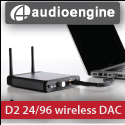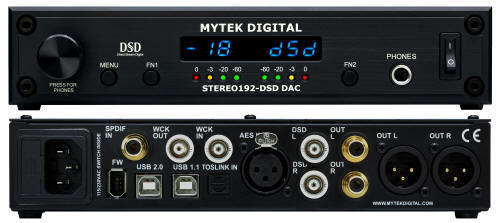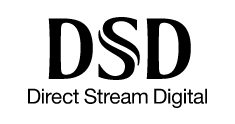|
|
You are reading the older HTML site
Positive Feedback ISSUE 66
mytek Stereo 192-DSD DAC - The Establishment of a New Standard as reviewed by Malcolm J. Gomes
[All photographs courtesy of Mytek Digital; cartoon by Bruce Walker] If you are old enough to remember the epic battle during the 1980s between Sony's Betamax versus JVC's VHS, you will recall that the former, even though it was a technically superior format to the latter, lost out due to marketing missteps, and it had to make that lonely trudge into obsolescence. I was in the audience when the late great Akio Morita, the Co-founder and Chairman of Sony and Consumer Electronics Hall of Famer gave the keynote address at the Summer CES at the McCormick Center in Chicago in 1990, where he focused on the reasons why the technically superior Betamax format lost out to the arguably inferior VHS format. That landmark battle was a classic marketing case study amongst many that proves the age-old marketing adage, "Perception is reality." It is not always the best product that wins, but rather, in many cases, the best-marketed product that prevails. The reason for revisiting that memory is that we are currently in the process where history could well repeat itself in the sphere of digital music file formats. There is no doubt that in this arena, the clear sales and popularity winners in the mass market are Apple iTunes and the MP3 format. However, in the high-resolution digital music file field the battle is still being waged and the undisputed crown here is still up for grabs. PCM-based formats like .WAV and .FLAC may currently be amongst the front-runners, but the proverbial dark horse is Direct-Stream Digital or DSD, the format developed by Sony and Philips and used by their SACD system. In my opinion, the reason for the failure of the SACD system despite its superior sound performance was because of gross overreach by the software piracy police of the industry, who made the system so incredibly restrictive when it came to transferring music to a computer or burning a duplicate disc that it shacked SACD users to an obscenely priced one-box player solution. This prompted many audiophiles that did invest in the SACD system to have a very limited SACD disc collection. A prominent exception is Dr. David Robinson, the Editor-in-Chief of Positive Feedback Online, who has an astounding collection of over 4,500 SACD discs, which is quite likely one of the largest private collections in the world.
DSD uses pulse-density modulation encoding, where the signal is stored as delta-sigma modulated digital audio, which is a sequence of single-bit values at a sampling rate of 2.8224 MHz. This is 64 times the sampling rate (44.1kHz) used by the CD system. DSD stores a delta-sigma signal before a decimation process is used to convert the data to a PCM signal (if it is to be sent to PCM). This enables DSD to deliver outstanding dynamic range (120 dB) and excellent extended frequency response (near 0 Hz to 100 kHz,) in part because it uses noise shaping quantization techniques that push 1-bit quantization noise well into the ultrasonic frequencies, which are inaudible to human hearing. [For much more on the nature of DSD see Lynn Olson's excellent recent articles for PFO in Issue 65, Issue 66 1 and Issue 66 2 – Ye Olde Editor] Since DSD is a 1-bit signal, it requires only a low pass filter to reconstitute the original analog waveform, which in theory puts it one step closer to purity because it dispenses with the requirement for a digital filter. This is of course an oversimplification, but not that far from reality. One hurdle in this process is that since most modern sigma-delta converters are multi-bit, they cannot properly dither 1-bit signals. Just as you have different resolutions in PCM like 16/44, 24/96 and 24/192, you also get the same with DSD, which comes in three flavors: DSD64, DSD128 (Double DSD), and DSD256 (Quad DSD). Going back to the Betamax versus VHS battle, the turning point was when the major hardware and software players started committing to one side or the other. When most of the big names decided to go the VHS route, that was the beginning of the end for Betamax. We are in a similar situation now with PCM and DSD. There are quite a few, albeit growing number of sites that offer DSD downloads. These include Opus3, Blue Coast Records, Channel Classics Records, Cybele Records, Downloads NOW, MA Recordings, Cybele Records, David Elias, Ototoy, Wheatus, DSDfile.com, HighResAudio and e-Onkyo. However, the major software download sites like HDTracks, Acoustic Sounds, and Linn Records have yet to commit to adding DSD to their catalog, which is currently dominated by PCM music files. This is despite the significant advantages offered by DSD. Unless one or more of them begins offering DSD downloads, this format will continue to face an uphill battle to establish itself. It is encouraging to hear that HDTracks and Acoustic Sounds are considering the prospect of adding DSD files to their catalog. On the hardware front there are many small, medium, and large brands that have had the courage and foresight to take the bull by the horns and introduce DSD-capable DACs. At the time of writing this, the list includes Mytek, Sonore, Chordette, Luxman, Auralic, Cary Audio, Chord Electronics, CH Precision, dCS, EMM Labs, Esoteric, Fostex, Lector Audio, EMM Labs, exaSound Audio Design, Korg, Matrix Audio, Lumin, MSB Technology, Lynx, Marantz, Meitner Audio, Lumin, Wadia, Simple Design, Pioneer Electronics, Ratoc Audio Lab, Teac, Playback Designs, TechDAS, Light Harmonics, Benchmark, Onkyo and Resonessence Labs. It is a bit of a Catch-22 situation at the moment. Many of the dominant brands that manufacture DACs are waiting for the major download sites to start offering DSD downloads, while the major download sites are hesitant to offer DSD downloads till more DSD-capable DACs, especially from the major brands, are available in the market. Some manufacturers I have spoken to opine that some so called DSD music file downloads currently being offered are not genuine, as they have been derived from PCM files, which they regard as misleading and even fraudulent! Hopefully 2013 will be the year that this logjam is broken and the floodgates will be opened for consumers, especially audiophiles, to enjoy the advantages of DSD performance, allowing this music file system to finally achieve the critical mass it deserves. DSD got a shot in the arm recently, when many audio hardware and software companies, including recording labels, agreed to support an open standard for sending stereo, mono and multi-channel DSD signals over USB. The basic framework for stereo has been completed, while the construction of a multi-channel version is underway. This is good news for DSD as it standardizes the way signals are transmitted from a computer to a DSD-capable DAC. The Mytek Stereo 192-DSD DAC Mytek was one of the very first brands to offer DSD capable DACs. Their Stereo192-DSD DAC is the subject of this review. Since 1992, Mytek has had a strong presence in the professional ADC and DAC space with many of their products finding their way into some of the most highly regarded recording and mastering studios in the world. The Stereo192-DSD is a well-built DAC and offers a plethora of options plus most of the connectivity that most audiophiles would ever require. The inputs include USB 1.1 and 2.0, Firewire, coaxial and optical SPDIF, word clock, AES/EBU, and serial DSD. The outputs include both single ended and balanced connections. For the purpose of the review I defeated the DAC's volume control and chose to use the balanced outputs to my preamp.
The Mytek Stereo 192-DSD DAC, Master Model (note the BNCs for DSD input, instead of RCA analog inputs) This DAC supports resolutions all the way up to 32/192kHz for PCM, and up to DSD128 via both USB 2.0 and Firewire, and can be hooked up to both PCs and Macs. Software for USB 2.0 and Firewire for both Macs and PCs can be easily downloaded and installed from the Mytek website. Additionally, the Mytek offers a choice of digital or analog volume controls and the option to bypass them for those using preamps. The unit offers two filters for PCM and one for DSD to roll off out of audio band frequencies. The ‘sharp' PCM filter comprises a brickwall cutoff at half the sampling rate while the ‘slow' filter applies a gentle cutoff with some aliasing. On the DSD side there are gentle cutoff frequencies at 50kHz, 60kHz, and 70kHz to reduce high frequency noise. The cherry on top is the switchable up-sampling option. Manipulating all these options is facile because of a very well thought out protocol operated through a clickable rotary control that doubles up as a volume attenuator, and which works in tandem with a menu button to scroll through and choose the setting options offered by the DAC. Mytek has made this process so intuitive, I was able to sprint up the learning curve without even referring to their well-compiled users manual. I have two caveats when using this Mytek DAC. The first is that it definitely needs at least 100 hours of break-in time. Out of the very well-packaged box, the unit sounds harsh, strained and as congested as a toddler with a full-blown cold and a basketball nose (which dribbles all over the place). However, after clocking a hundred hours it sounded like a different animal altogether. The second caveat is that to get the most out of this Mytek DAC when playing tunes through your computer, make sure you have enough RAM memory installed. Both Mytek and Pure Music (my media player of choice) recommend a minimum of 8 GB of RAM. Since my iMac has 12 GB of RAM, it has more than enough for the task at hand. The Sound I did this review with an emphasis on DSD music files, and how well-recorded DSD files perform when processed by this DAC. Right from the start of the audition, the Mytek showcased the intrinsic advantages of well-recorded DSD music files. Although the sound quality of PCM based music files have improved quite exponentially as they progressed from 16/44 to 24/96 and on to 24/192, many ultra-sensitive ears can still detect a smidgen of unwelcome vestiges of "digital" sound, striking one's ears like glare, glassiness, and grain. With DSD, most of these undesirable characteristics are minimized to a level where the sound approaches the silky smoothness and ease of some of the best analog reproductions that I have heard.
The Mytek Stereo 192-DSD DAC: Silver faceplate without VU LEDs On this Mytek DAC I did most of my DSD listening using the single and double DSD tracks from Opus3 Records [available at their new DSD downloads store: http://www.dsdfile.com], which have been taken from the original 15ips half-track master tapes. This was accomplished with the typical Opus3 penchant for perfection that amply manifests itself in the sound quality. The smoothness and effortlessness with which the tunes flow should make all but the most ardent analog fanatics reconsider their decision to keep digital audio at arms length. Leading edges are better defined, transients are crisp, even subtle, highly nuanced notes that usually get drowned out or overshadowed, were rendered with the same finesse, fragility, intricacy and delicateness of a butterfly's wing. Bass notes are incredibly deep, taut, and tuneful. Higher frequencies come through with seductive sweetness that is rare for DACs in this price range. For many years I played the piano for a rock band, so I have a very good mental reference of what a piano should sound like. DSD files played through this Mytek DAC surprised me with the clear bell-like quality that each piano note is rendered, from gentle pianissimo to robust fortissimo. With recordings of live concert performances, I am more than pleased with the way I can easily detect the unique and distinctive acoustical properties of the concert venue. With well-recorded DSD tracks I am able to hear my favorite tunes at a louder volume level before detecting distortion and compression. Vocals, especially seductive renditions by husky-voiced jazz female vocalists come through with a hint more emotion, immediacy, and palpability as compared to the same music on well-recorded 24/192 .WAV files. On choral tracks, DSD files via the Mytek have slightly more transparency and presence than their 24/192 PCM counterparts. Track after track, the strain-free flow of music gently caresses my ears with sound that is as satiny smooth as a baby's bottom. This translates to minimal fatigue that allows me to listen for hours together and still want more. I know that technically there should not be any performance difference between a USB 2.0 cable and a Firewire connection, because both are capable of delivering bit-perfect data transfer, but with this DAC I can consistently tell the difference between the two. My iMac via Firewire delivers sound that is a wee bit cleaner and more relaxed. The headphones performance of the Stereo192-DSD is par for the course. Through my trusty Sennheiser HD 600, this DAC has better than average performance for its price, but it sounds a bit veiled when compared to a few other DACs with headphone outputs in the same price range. When I compared the same music on DSD64 and DSD128 files, on some tracks I am not able to detect any difference. However on tracks where voices, string and wind instruments are prominent, I am able to feel more emotion in the music and hear greater realism due to more rounded and fuller notes with better midrange saturation with the DSD128 files. I do not have any DSD256 (Quad) music files to compare, and the Mytek is not capable of handling them anyway. Given what the DSD128 resolution is capable of, I would hazard a guess that Quad DSD would be overkill. With high-rez PCM music files, the Mytek Stereo192-DSD performs very well for its price of $1595. In fact in terms of sheer transparency, tonal accuracy, and dynamic contrast, it is one of the best sub $2000 DACs I have heard. However, this DAC really shines when processing well-recorded DSD files. I have not heard another DSD-capable DAC below $2000 that handles DSD files as well as the Stereo192-DSD does. Conclusion To summarize, the Mytek 192-DSD is one of the best values in its price range and has the best DSD performance of all the DACs I have heard under $2000. It delivers a relatively fatigue-free and very musical performance because of its uncanny ability to deliver resolution without sounding analytical. It has better build quality and more connectivity and functionality than most of the DACs in the sub $2000 category. If you have a budget of $2000, have multiple digital music sources, and are in the camp that believes that DSD is going to be a major music file format going forward, it would behoove you to put the Mytek 192-DSD on your shortlist. Malcolm J. Gomes
Mytek Stereo192-DSD
Mytek
|













